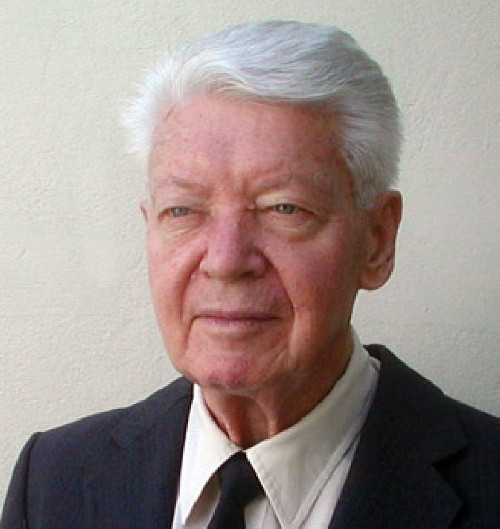 Esteban Bajaja (Photo courtesy of KONEX Foundation)
Esteban Bajaja (Photo courtesy of KONEX Foundation)
Esteban Bajaja
Contributed by Kiko Testori and Richard Wielebinski
Esteban Bajaja was born on October 7, 1931 in Santa Fe, Argentina and died on June 12, 2015. He was responsible for the development of radio astronomy in Argentina. Estaban Bajaja graduated from the University of Buenos Aires in 1963 and received his doctoral degree from the National University of la Plata in 1969. His career developed as a member researcher in CONICET. He was actively involved in the development of the Instituto Argentino de Radioastronomia (IAR) and served two periods as its Director.
The beginning of radio astronomy in Argentina goes back to contacts of various local institutions in the 1950s with the Carnegie Institution in Washington (CIW). Already in 1957 Merle Tuve (CIW) visited Argentina and argued for a radio astronomy observatory in South America. By 1959 there was a discussion about the foundation of a Carnegie Southern Station in collaboration with the La Plata Observatory. Sometime in 1962 the decision was taken to construct a 30m parabolic radio telescope at the Villa Elisa site. On graduation in 1963 Esteban joined the newly founded Instituto Nacional de Radioastronomia (INRA) later called the Instituto Argentino de Radioastronomia (IAR) . The aim was to construct a radio telescope for the 21cm HI line observations which became the main direction of Esteban's research. The first 30m antenna was dedicated on 26th March 1966. The construction of a second 30m dish followed. Esteban Bajaja visited many observatories in the world, including NRAO, Leiden, and MPIfR, in the quest to obtain background information and state of art receivers for "his" telescopes.
The most important, highly cited, scientific heritage from Esteban Bajaja's life is the Leiden/Argentina/Bonn (LAB) survey of Galactic HI. This important survey is essential for the study of Galactic HI and became possible only with Esteban's drive and ability to obtain the necessary resources and to motivate people in various observatories. His other important contributions are in the studies of HI in nearby galaxies: M31, Magellanic Clouds, and other southern galaxies. The existence of the SEST radio telescope at the ESO site in la Silla led to CO observations of southern galaxies. Esteban supported radio continuum observations of the southern Milky Way and of nearby galaxies as well. Again a joint project with the MPIfR resulted in an all sky 1400 MHz survey with full polarization data.
Esteban Bajaja was the Director of IAR first in 1975-1985 and later in 1995-1997. He was the President of Argentina Astronomy Association (AAA) in 1990-1993. He was also instrumental in the organisation of the IAU General Assembly in 1991 which was held in Buenos Aires. In 2003 he received the Konex prize in Science and Technology, a distinction that is awarded annually to personalities most distinguished in Argentina's national life. The asteroid 5386=1975 TH6 was named Bajaja in his honour.
For all of us who knew Esteban, vivid memories of a gentle and dedicated astronomer will remain. He mastered many problems in his life, always dedicated to the well being of his institute. Esteban Bajaja went out of his way to support younger researchers, arranging for them to visit observatories worldwide. His seeds for radio astronomy in Argentina are reaping a good harvest.
Modified on Monday, 14-Feb-2022 09:12:33 EST by Ellen Bouton, Archivist (Questions or feedback)
|
![[IAU logo]](iau_wb_thumb.jpg)
![[URSI logo]](URSI-logo-thumb.jpg)
![[Karl Jansky at his antenna]](jansky_photo_02_thumb.jpg)
![[Reber's Wheaton antenna]](Reber_Telescope_Wheaton_thumb.jpg)
![[Dover Heights]](Dover_Heights_02_thumb.jpg)
![[4C telescope]](GB61-195_4C_telescope_thumb.jpg)
![[Ewen and horn antenna]](ewen_horn1s.jpg)
![[Dwingeloo, 1956]](Dwingeloo-1956-thumb.jpg)
![[Jocelyn Bell Burnell and Cambridge antenna used in pulsar discovery]](burnell2_thumb.jpg)
![[Lovell Telescope at Jodrell Bank]](site_1594_0001-500-334-20180316163019-thumb150.jpg)
![[Wilson, Penzias, and Bell Labs horn antenna]](wilson-penzias-horn_thumb.jpg)
![[6-m Millimeter Radio Telescope in Mitaka, Japan]](6m-thumb.jpg)

